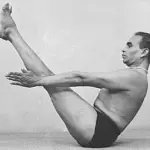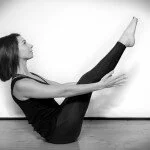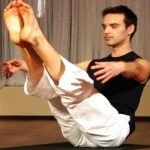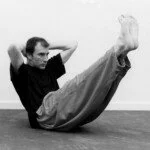Navasana (“Boat Pose”) is an asana. Variations include Paripurna Navasana (Sanskrit: परिपूर्णनावासन; IAST: paripūrṇanāvāsana “Full Boat Pose”), Ardha Navāsana (Sanskrit: अर्धनावासन “Half Boat Pose”) and ekapadanavasana (“one legged boat pose”).
The name comes from the Sanskrit words nava meaning “boat” and asana (आसन) meaning “posture” or “seat”. In its literal translation, “Boat Pose”, the body could be imagined to resemble a boat, entirely balanced on the buttocks.
Step by Step:-
- Begin from a seated position with your legs straight out in front of you.
- Bend your knees so that your feet are flat on the floor.
- Keep your knees and legs together throughout the pose.
- Place your hands behind your hips and keep your fingers pointed forward towards your feet.
- Now slowly lean back on your hands and lift your legs a few inches off the floor.
- Make sure that your back does not round or bend.
- Maintain the neutrality of your shoulders and draw the shoulder blades back and down to help open up the front of the chest.
- Lift your chest and sternum upwards.
- Keep your abdomen muscles tightened and your belly as flat as possible.
- Exhale and straighten out your legs while you raise them off the floor.
- If you cannot straighten your legs completely, you can keep them slightly bent until your core muscles become stronger.
- Remove your hands from the floor and raise them in front of your chest.
- At this point, your palms should be facing down and the arms should be parallel to the floor.
- If this is not possible, you can hold on to the backs of your thighs.
- Breathe normally and hold the pose for 30 seconds.
- As you advance in your practice, you should be able to hold the pose for a minute at a time.
- Do not lose the integrity of the pose by either sinking into your chest or lowering your legs.
- Keep your chin parallel to the floor throughout the pose.
- Release the pose by bending your knees and lowering your feet back to the floor.
Precautions:-
There are a number of precautions that you need to take before you venture into the pose. Paripurna Navasana is not advisable if you suffer from –
- Asthma
- Diabetes
- Chronic headaches
- Heart problems
- Insomnia
- Low blood pressure
- Injury to the abdomen
- Knee, hip, shoulder, or arm injury
Women who are menstruating or are pregnant should avoid the pose as well.
If you tend to suffer from neck problems or have had a recent neck injury, perform the Full Boat Pose against a wall to prevent neck strain. In such situations you can rest your head against the wall as you extend your legs in front of you. Always practice this pose under the supervision of a trained instructor if you are a beginner or have suffered any recent injury to any of your body parts.
Beginner’s Tip:-
If this pose is too challenging for you, you can practice by sitting on the edge of a chair with your knees bent at right angles. Hold the sides of the chair with your hands and gently lean your body forward. Straighten out your arms and lift your buttocks off the seat of the chair. Hold this pose and raise your heels off the floor. At this point make sure that only the heels are off the floor and not the balls of your feet. Raise your sternum forwards and upwards and hold the pose for 30 seconds at a time. This will help strengthen your core and leg muscles and get them ready to perform the Full Boat Pose.
As a beginner, you can also use a strap around the soles of your feet to help straighten your legs and hold the pose for longer. As you move into the pose, push your feet against the strap and keep it taut.
Benefits:-
- Performing the pose helps strengthen the core muscles of the abdomen
- The pose stretches and strengthens the hips flexors
- It also helps in stretching the hamstrings
- It helps improve alignment by stretching the spine
- The pose helps tone the small and large intestines
- It also strengthens the lower back muscles
Therapeutic Applications:-
- Stimulate the kidneys
- Improve the functioning of the thyroid
- Stimulate the prostate glands
- Improve digestion
- Relieve stress
- Improve balance
Variations:-
Variation 1 –
- Reach out and interlace your index and middle fingers around your big toes and stretch through your legs.
Variation 2 – Half Boat Pose or Ardha Navasana
- From Full Boat Pose, slowly lower your legs to the floor.
- Place your hands behind your head and stretch the elbows out to the sides in a line with your ears.
- Round your back but make sure the lower back is still off the floor.
- The tips of your toes should be in line with your eyes.
Preparatory Poses:-
Before performing the Paripurna Navasana you could perform some of the other poses so that your body is prepared well to perform the Full Boat Pose. Some of these poses include:
- Adho Mukha Svanasana or Downward Facing Dog
- Bound Angle Pose or Baddha Konasana
- Standing Forward Bend or Uttanasana
- Half Spinal Twist or Ardha Matsyendrasana
- Staff Pose or Dandasana
- Easy Pose or Sukhasana
- Cow Pose or Gomukhasana
Follow Up Poses:-
- Downward Facing Dog or Adho Mukha Svanasana
- Seated Forward Bend or Paschimothanasana
- Bound Angle Pose or Baddha Konasana
- Seated Angle Pose or Upavista Konasana
- Plow Pose or Halasana
- Supported Headstand or Salamba Sirsasana
- Chair Pose or Utkatasana
- All Supine Poses








